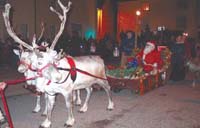Huge plastic statue of Santa Claus erected in Turkey among palms
What's a huge plastic statue of Santa Claus doing among palm trees in a seaside town in Turkey?

The mayor's answer is simple: He's back home.
Suleyman Topcu put up the statue last year in the Mediterranean town of Demre to do honor to its favorite son St. Nicholas, the inspiration for the Santa legend.
Some residents are horrified, especially since the Santa statue, replete with cotton-candy beard and red-and-white outfit, replaced a more solemn sculpture of St. Nicholas that was a gift from the Orthodox Christian community, and featured him with a halo and an open bible.
"The modern statue looks like a cheap toy, it has no artistic value at all," Ayse Uslusaydam, a pharmacist in Demre, said by telephone on Thursday. "The previous one had a style."
St. Nicholas served as bishop of Demre in the 4th century A.D. From there, the legend of his generosity spread around the world and became interwoven with mythical stories of the jolly gift-bringer.
For many Orthodox Christian Russians, St. Nicholas is an object of deep veneration rather than the father Christmas known to millions around the world.
Topcu acknowledged that some people were upset.
"I can't say one hundred percent that all are happy with it. Tourists, including Russians, have also reacted," said Topcu. "If needed we could put the statue of St. Nicholas back."
Legend has it that one night, St. Nicholas threw a sack of gold through the open window of a poverty-stricken man who could not pay the wedding dowries of his three daughters. The next night, he tossed a second sack.
On the third night, the window was closed and St. Nicholas climbed onto the roof and dropped the pouch down the chimney, which landed in the girls' stockings drying in the fireplace.
The Santa character later took on the white beard of the pagan god Odin and Odin's eight-legged flying horse became eight reindeer.
The ability to enter houses down the chimney comes from an old Norse legend, and the tradition of leaving him cookies and milk is derived from a medieval German tale, reports AP.
In the 12th century, French nuns began to give gifts in St. Nicholas' name on his feast day, Dec. 6. St. Nicholas gift-giving was later blended with the three wise men bearing gifts for the newborn Jesus and associated with Christmas.
The image of today's Santa is a product of Coca-Cola commercials in the 1930s. And Rudolph, the red-nosed reindeer, was created for an ad campaign for the Montgomery Ward department store chain.
Hundreds of Greek and Russian Orthodox worshippers commemorate St. Nicholas' death every Dec. 6 in the church of St. Nicholas in Demre where he was originally entombed.
Subscribe to Pravda.Ru Telegram channel, Facebook, RSS!


